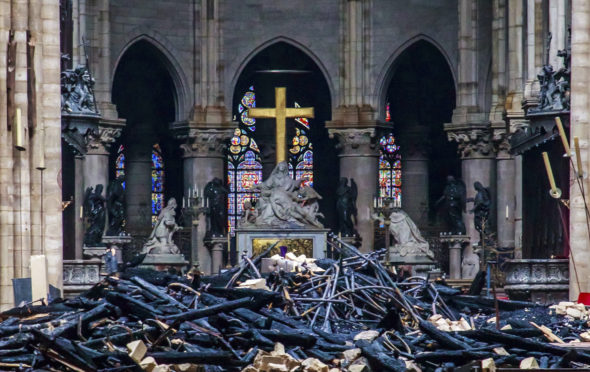There was something about the fact that the Notre Dame fire happened in Holy Week that made it seem all the more portentous; the soaring needle of the cathedral’s spire raging from within with livid flames, before falling through the Parisian sky like a giant firework, while locals gasped and wept below.
As Easter approached, it was hard not to see the icon of French Catholicism and culture as a metaphor for the global church itself, an institution that is overheating, imploding under the pressure, and coming dangerously close to irreversible damage.
Notre Dame is famous for the beauty of its rose windows, a kaleidoscope of intense purple, blue, and pink stained glass, but also for the ugliness of the gargoyles that look out menacingly over the Paris skyline. Beauty and ugliness cheek by jowl, as they so often are, both in life and in the church. Notre Dame, it is worth remembering, is not just an historic building, but a living church community.
I felt uneasy about this tussle between secular and spiritual when reading about the donations of two French magnates, Bernard Arnault and Francois Pinault, for the restoration of Notre Dame. Pinault, whose Kering group owns fashion houses such as Yves St Laurent, Gucci and Alexander McQueen, pledged 100 million euros.
Then his rival Aranult, of the LVMH group which owns Dior, Louis Vuitton and Givenchy, trumped him, pledging 200 million. Millions more followed. Ironic that the custodians of some of the world’s most prestigious labels moved in to save a landmark of the failing brand of the global Catholic Church plc.
Don’t get me wrong. Culture, heritage, the preservation of outstanding human creativity – it’s all important. Who could fail to be moved by the sight of Parisians gathering on the banks of the Seine, as flames ripped through the medieval cathedral, singing hymns and praying, “Je vous salue Marie” to Our Lady? Or by the young man who said, “It was important for me to come, to come and see her, maybe for the last time before she is no longer here.”
Understandable, but the point is that Notre Dame is not a “she”. There is no person involved, no loss of life. And I wonder what awful human tragedy would prompt the fashion houses to dig deep and donate 300 million overnight. The external splendour of the church burned when flames licked round Notre Dame. But the screams of abuse victims trapped inside churches have been resounding across the world for years. Who has heard? Which fashion house has donated millions to save what is much harder to restore than bricks and mortar: the human psyche?
“Suddenly we realise what our churches can mean,” said Bishop Hugh Gilbert, president of the Scottish Bishops’ Conference. But what church means is not architectural beauty. Pope Francis recently visited the church of San Gulio Papa in Italy, where a collapsed roof had been restored. Church was not about walls, he pointed out. It was about the human face of Christ: the poor, hungry, and needy. Francis has also criticised “the scandalous sums” that are immediately raised when a bank collapses. Notre Dame is the ecclesiastical equivalent of a bank, the institutional cladding on something even more important. It is time to look inside that edifice with a more critical eye.
Ironically, as fire raged, I was dealing with emails from a group of men, now mostly in their 60s, who studied for the priesthood at Mirfield seminary in Yorkshire and were systematically abused over many years. One copied me into a letter to the powerful Maltese Archbishop, Charles Scicluna, who has become the international face of the church’s handling of abuse. Publically, Scicluna emphasises engagement with victims. Privately, the Mirfield letters castigate him for his failure to reply to the men, his lack of empathy, and his inaction. Interesting, then, that while Scicluna did not seem to have time to write letters to victims, he did have time to publicly tweet his “horror” at the Notre Dame fire.
Oh, that people got the attention of cathedrals! As head of the CDF in Rome, Pope Emeritus Benedict presided over the church’s disastrous cover up of abuse for over 20 years, but he has just emerged from seclusion to claim in a statement – to the ridicule even of Catholic theologians – that the sexual revolution of the 1960’s was to blame, because it had made the abuse of children “allowed and appropriate”. On which planet
Holy Week is the pinnacle of Catholic faith: the encapsulation of birth, death, resurrection and salvation. Notre Dame is a jewel, one of its – many – earthly treasures. A French junior interior minister said it is unclear how fire damage will affect the building long-term. The same uncertainty hangs over the church itself. You do not need to be religious this Easter to hope that the cathedral will be restored to its former glory. Nor need you be a believer to realise it is important for the church to save not just its cultural buildings, but its heart and soul.
Catherine Deveney is an award-winning investigative journalist, novelist and television presenter











